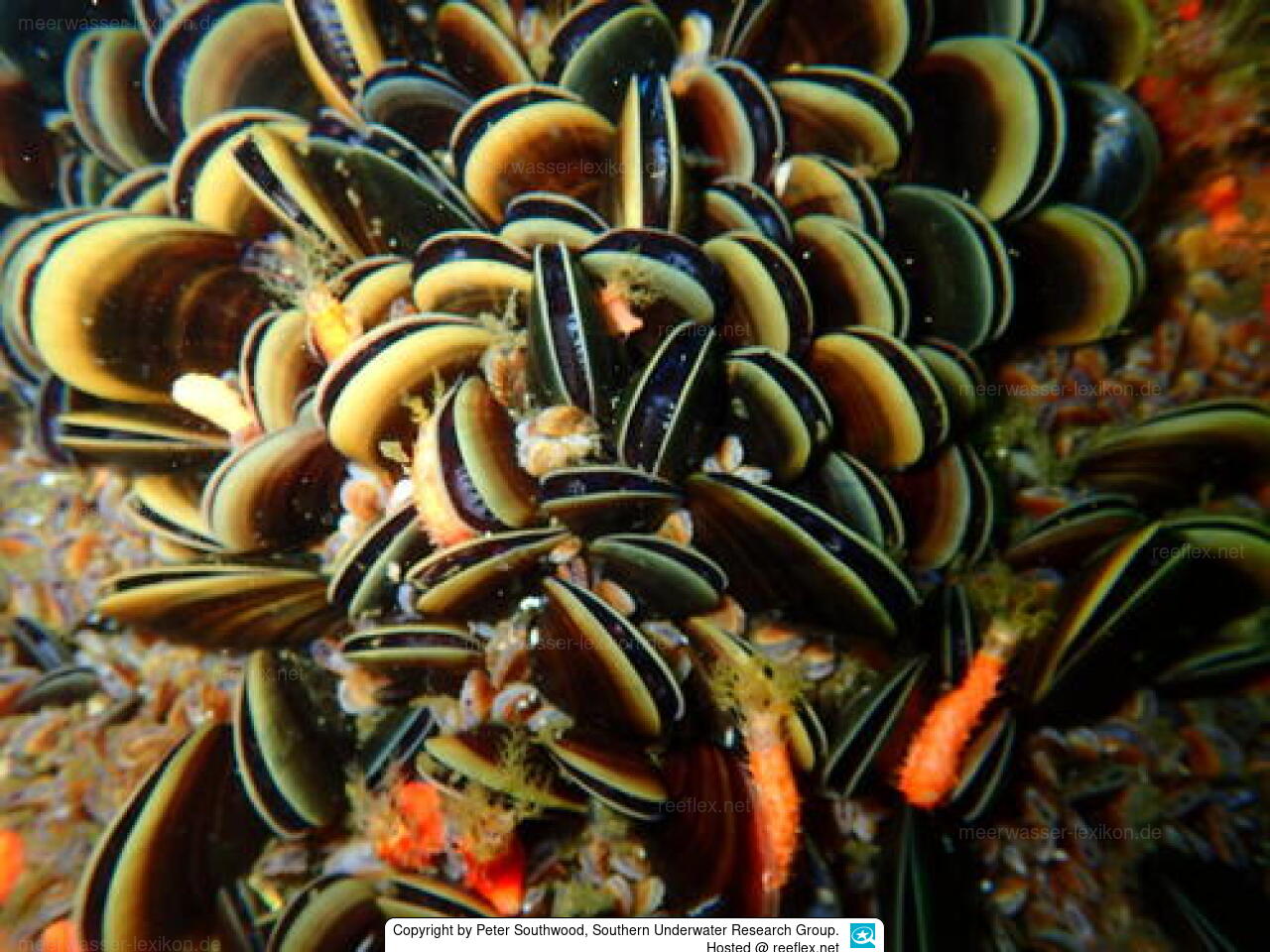Info
If you look at the occurrence and distribution of species, you will stumble over the words "native and invasive species".
What are invasive species?
An "alien species" has been introduced from its natural range into another, foreign area or country, manages to survive there and then reproduces.
"Invasive" becomes this species when it spreads and thereby endangers biodiversity, other animal and plant species, and thus native ecosystems°.
https://www.tierschutzbund.de/information/hintergrund/artenschutz/invasive-arten/
Following this definition, it does not matter in the first place how the alien antennae entered foreign distribution areas, by their own force, by natural forces, or deliberately introduced by humans.
Perna perna is one such species, also known as a neobiota or bioinvasor, this species of mussel was deliberately introduced by humans into the waters of Canada, the East Coast of the United States and the Gulf of Mexico for profit, in this case for human consumption.
Today's mussel fishery represents a combination of wild mussel fishing and extensive bottom culture management. The basic principle of mussel fishery is to fish young mussels from natural banks and sow them on more favorably located cultivated areas.
http://www.muschelfischer.de/mufi_fang.htm
The product of mussel reproduction (female mussels can release between 5 to 12 million eggs 3 times per year, which are then inseminated by male mussels) are the veliger larvae, which are subject to the forces of wave action and drift.
If the bioinvasors have established themselves in foreign areas, then they can, more or less quickly displace native species and are very difficult to remove from these biotopes.
More information on invasive species can be found here:
https://www.bmuv.de/themen/naturschutz-artenvielfalt/artenschutz/nationaler-artenschutz/invasive-gebietsfremde-arten
In this age of massive environmental degradation, resourceful researchers are also coming up with new ideas to sequester carbon, again using mussels, see the report "Mussels and other blue mussels, aquaculture for carbon sequestration"
https://www.greatitalianfoodtrade.it/de/Fortschritt/Miesmuscheln-und-andere-Aquakulturmuscheln%2C-die-Kohlenstoff-binden/
Color of the mussel:
Brown or tan on the outside with concentric yellow bands near the ventral edge, purple on the inside, pearly.
Shell surface is smooth except for fine growth lines
Synonyms:
Melina perna (Linnaeus, 1758)
Mya perna Linnaeus, 1758
Mytilus afer Gmelin, 1791
Mytilus africanus Fischer von Waldheim, 1807
Mytilus africanus Chemnitz, 1785
Mytilus africanus var. mauretanica Pallary, 1900
Mytilus africanus var. mauretanicus Pallary, 1900
Mytilus elongatus Fischer von Waldheim, 1807
Mytilus elongatus Chemnitz, 1785
Mytilus irisans Jousseaume, 1888
Mytilus magellanicus Röding, 1798
Mytilus perna (Linnaeus, 1758)
Mytilus perna var. trigona Krauss, 1848
Mytilus pictus Born, 1778
Mytilus variegatus Röding, 1798
Mytilus versicolor Gmelin, 1791
Perna africana (Chemnitz, 1785)
Perna africana var. mauretanica Pallary, 1900
Perna africana var. tingitana Pallary, 1900
Perna indica Kuriakose & Nair, 1976
Perna magellanica Philipsson, 1788
Perna perna f. picta (Born, 1778)
Perna picta (Born, 1778)
What are invasive species?
An "alien species" has been introduced from its natural range into another, foreign area or country, manages to survive there and then reproduces.
"Invasive" becomes this species when it spreads and thereby endangers biodiversity, other animal and plant species, and thus native ecosystems°.
https://www.tierschutzbund.de/information/hintergrund/artenschutz/invasive-arten/
Following this definition, it does not matter in the first place how the alien antennae entered foreign distribution areas, by their own force, by natural forces, or deliberately introduced by humans.
Perna perna is one such species, also known as a neobiota or bioinvasor, this species of mussel was deliberately introduced by humans into the waters of Canada, the East Coast of the United States and the Gulf of Mexico for profit, in this case for human consumption.
Today's mussel fishery represents a combination of wild mussel fishing and extensive bottom culture management. The basic principle of mussel fishery is to fish young mussels from natural banks and sow them on more favorably located cultivated areas.
http://www.muschelfischer.de/mufi_fang.htm
The product of mussel reproduction (female mussels can release between 5 to 12 million eggs 3 times per year, which are then inseminated by male mussels) are the veliger larvae, which are subject to the forces of wave action and drift.
If the bioinvasors have established themselves in foreign areas, then they can, more or less quickly displace native species and are very difficult to remove from these biotopes.
More information on invasive species can be found here:
https://www.bmuv.de/themen/naturschutz-artenvielfalt/artenschutz/nationaler-artenschutz/invasive-gebietsfremde-arten
In this age of massive environmental degradation, resourceful researchers are also coming up with new ideas to sequester carbon, again using mussels, see the report "Mussels and other blue mussels, aquaculture for carbon sequestration"
https://www.greatitalianfoodtrade.it/de/Fortschritt/Miesmuscheln-und-andere-Aquakulturmuscheln%2C-die-Kohlenstoff-binden/
Color of the mussel:
Brown or tan on the outside with concentric yellow bands near the ventral edge, purple on the inside, pearly.
Shell surface is smooth except for fine growth lines
Synonyms:
Melina perna (Linnaeus, 1758)
Mya perna Linnaeus, 1758
Mytilus afer Gmelin, 1791
Mytilus africanus Fischer von Waldheim, 1807
Mytilus africanus Chemnitz, 1785
Mytilus africanus var. mauretanica Pallary, 1900
Mytilus africanus var. mauretanicus Pallary, 1900
Mytilus elongatus Fischer von Waldheim, 1807
Mytilus elongatus Chemnitz, 1785
Mytilus irisans Jousseaume, 1888
Mytilus magellanicus Röding, 1798
Mytilus perna (Linnaeus, 1758)
Mytilus perna var. trigona Krauss, 1848
Mytilus pictus Born, 1778
Mytilus variegatus Röding, 1798
Mytilus versicolor Gmelin, 1791
Perna africana (Chemnitz, 1785)
Perna africana var. mauretanica Pallary, 1900
Perna africana var. tingitana Pallary, 1900
Perna indica Kuriakose & Nair, 1976
Perna magellanica Philipsson, 1788
Perna perna f. picta (Born, 1778)
Perna picta (Born, 1778)







 Peter Southwood, Southern Underwater Research Group, Australien
Peter Southwood, Southern Underwater Research Group, Australien



